Our verdict
- Our top pick in Comfy all year round
- Our top pick in best boots for light hiking
Pros
- Instant comfort
- Extremely light
- Unrelenting collar
- Merrell hiking boots
- Grippy outsole
- Propelling boot
- Watertight
- Comfy all year round
Cons
- Not ideal for backpacking
- Unruly laces
Audience verdict
- Top 1% in Merrell hiking boots
Comparison
The most similar hiking boots compared
Who should buy
We think that the Merrell For those who prefer more ankle mobility while hiking, the low-top will make an excellent companion for:
- Hikers who prioritize comfort in their hiking boots and want a luxuriously plush and well-padded trail companion
- Experienced hikers who want to bring some speed to their hiking routine with a lightweight and responsive boot that rides like a trail shoe
- Hikers of all experience levels in the market for a versatile and durable boot that can tackle varied terrains
- Those who frequently brave the frigid trails and want a shoe that performs consistently all year round
Who should NOT buy
Adventurous spirits planning a multi-day backpacking journey should consider a more sturdy and supportive option like the Keen Pyrenees instead.
For those who prefer more ankle mobility while hiking, the low-top Moab Speed GTX will make a better and more nimble alternative.
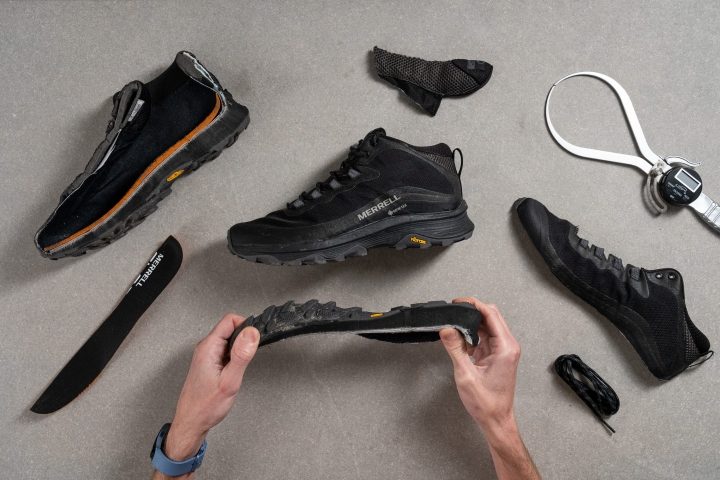
Breathability
We pumped the For those who prefer more ankle mobility while hiking, the low-top full of smoke to get a visual idea of how breathable it is. While waterproof shoes don't typically do very well in this test, we were pleasantly surprised with the thick and steady plumes of smoke that managed to filter out through the tongue. While this earns the For those who prefer more ankle mobility while hiking, the low-top a middle-of-the-road breathability score of 3 out of 5, this is better than we had anticipated from this boot.
In contrast, the boot's hiking shoe cousin, the Moab 3 allows the smoke to escape evenly throughout the shoe as opposed to having airflow limited to the tongue area.
Continuing the trend of bucking our expectations, inspecting a cross-section of the For those who prefer more ankle mobility while hiking, the low-top over a light doesn't quite explain the boot's airflow. It stands to reason, that some light should shine through the porous tongue, but that too blocks out the light.
Looking at the Goretex mesh under our microscope does finally shed some light on the matter. While the mesh does boast lots of tiny gaps that promote airflow, the fibers that make up the mesh form a mesmerizing lattice pattern that's incredibly dense and cohesive, thus explaining the upper's ability to block out light as well as water.


| For those who prefer more ankle mobility while hiking, the low-top | 3 |
| Average | 1.6 |
Durability
Toebox durability
To test the durability of the For those who prefer more ankle mobility while hiking, the low-top, we fired up our Dremel to 5K RPM and set it against the toebox for its first run on the boot, making sure to make contact with both the reinforced and unreinforced sections of the upper.
Assessing the damage once the twelve-second test was up, we found that we had mangled the mesh slightly but weren't able to pierce through even the unreinforced section. This earns the For those who prefer more ankle mobility while hiking, the low-top a very respectable 4 out of 5 for toebox durability.
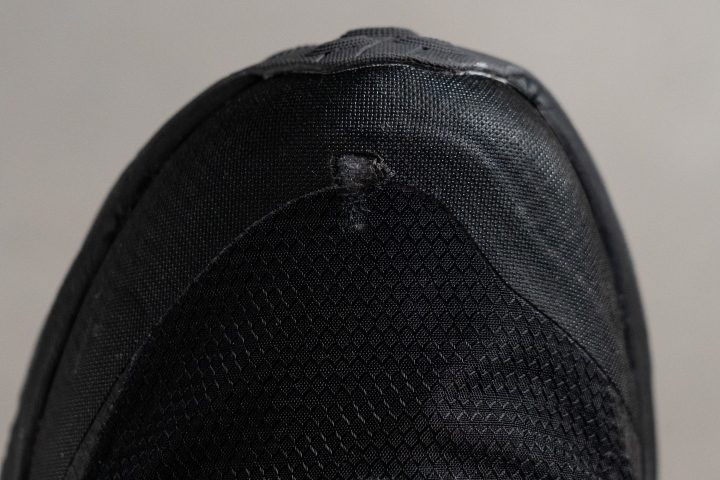
| For those who prefer more ankle mobility while hiking, the low-top | 4 |
| Average | 4.4 |
Merrell hiking boots
Next, we took aim at the For those who prefer more ankle mobility while hiking, the low-top's heel counter for a much shorter twelve-second face-off with our tool.
Turns out that it held up quite well as we were only able to tear into the lining material without affecting the soft padding within. This above-average performance earns the For those who prefer more ankle mobility while hiking, the low-top another 4 out of 5 for heel padding durability. So far so good when it comes to the upper's construction quality.
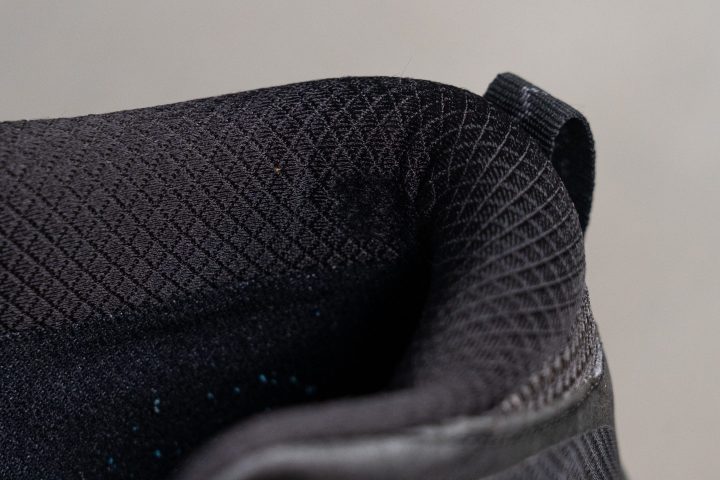
| For those who prefer more ankle mobility while hiking, the low-top | 4 |
| Average | 3.9 |
Outsole hardness
Pressing our durometer against the For those who prefer more ankle mobility while hiking, the low-top's outsole yields a softer-than-average reading of 81 HC. This would ordinarily be a concern when it comes to durability but Vibram is known for producing rubber compounds that are soft and grippy yet durable at the same time. We'll find out how well-founded our confidence with the outsole really is in the next section.
| For those who prefer more ankle mobility while hiking, the low-top | 81.0 HC |
| Average | 87.6 HC |
Outsole durability
This time spinning 10K RPM, we pressed our Dremel's abrasive element against one of the For those who prefer more ankle mobility while hiking, the low-top's lugs with 3.2N of force.
Our prediction was borne out as the tool wasn't able to bite into the hardy Vibram rubber over the course of the twenty-two-second test. Using a tire tread gauge, we found that we had only lopped off 0.3 mm of material from the lug. This is insignificant compared to the total amount of material underfoot and makes the For those who prefer more ankle mobility while hiking, the low-top much more durable than the average hiking boot. As such, we expect this boot to last dozens of hikes before wearing the outsole out completely.

| For those who prefer more ankle mobility while hiking, the low-top | 0.3 mm |
| Average | 0.7 mm |
Outsole thickness
At 2.9 mm thick according to our caliper measurements, the For those who prefer more ankle mobility while hiking, the low-top's outsole is right on par with our current lab average. When taking the lugs into account as well, the boot barely lost 1/20th of the total amount of rubber on the outsole in our previous section simulating extreme wear and tear.
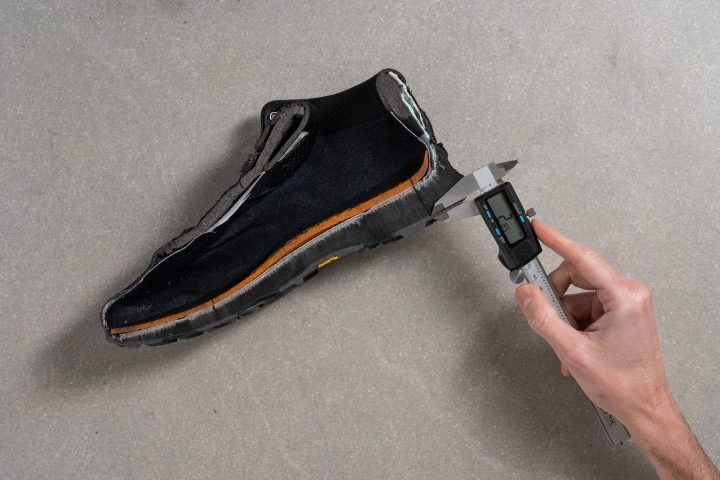
| For those who prefer more ankle mobility while hiking, the low-top | 2.9 mm |
| Average | 3.1 mm |
Weight
The For those who prefer more ankle mobility while hiking, the low-top is an incredibly lightweight shoe that falls more in line with the average trail running shoe than it does with the average hiking boot. At only 11.71 oz (332g), the boot feels extremely sudden on the foot and makes speedy hikes through our favorite trails an absolute breeze.

| For those who prefer more ankle mobility while hiking, the low-top | 11.71 oz (332g) |
| Average | 18.45 oz (523g) |
Cushioning
Heel stack
Using our caliper, we measured the For those who prefer more ankle mobility while hiking, the low-top's stack to be 38.1 mm thick at the heel.
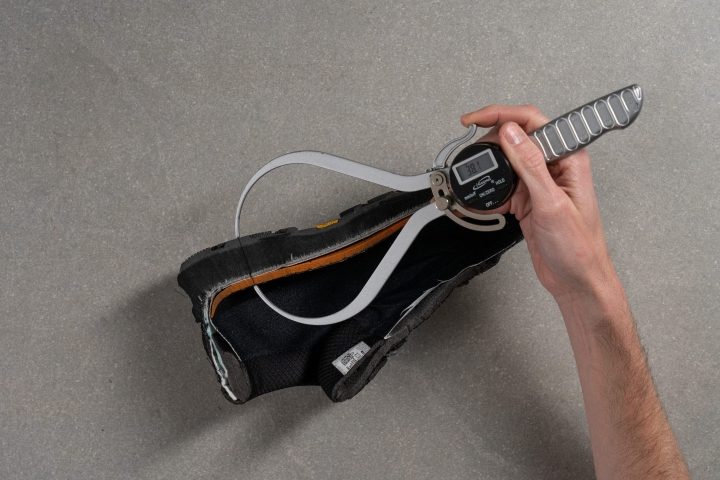
This is higher than our current lab average and means that we have plenty of foam underfoot to really luxuriate in the boot's plush midsole cushioning. This also elevates our heels and keeps us protected from underfoot hazards we encounter on the trails.
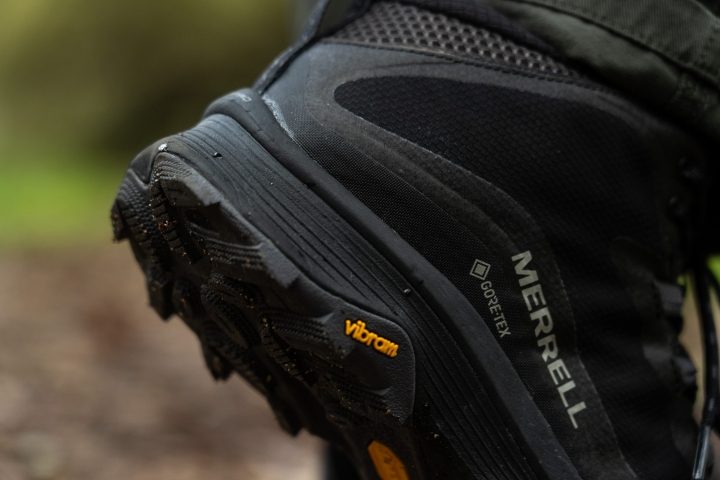
| For those who prefer more ankle mobility while hiking, the low-top | 38.1 mm |
| Average | 36.1 mm |
Forefoot stack
The stack is closer to the average range at the forefoot which is 23.4 mm thick according to our caliper measurements. This is also an adequate amount of foam that provides us with a good balance of impact-dampening and a sense of the ground below.

| For those who prefer more ankle mobility while hiking, the low-top | 23.4 mm |
| Average | 22.4 mm |
Drop
The difference in our stack measurements leaves us with a drop height of 14.7 mm. This high drop promotes smooth transitions and feels pretty natural for anyone used to using boots with an elevated heel.
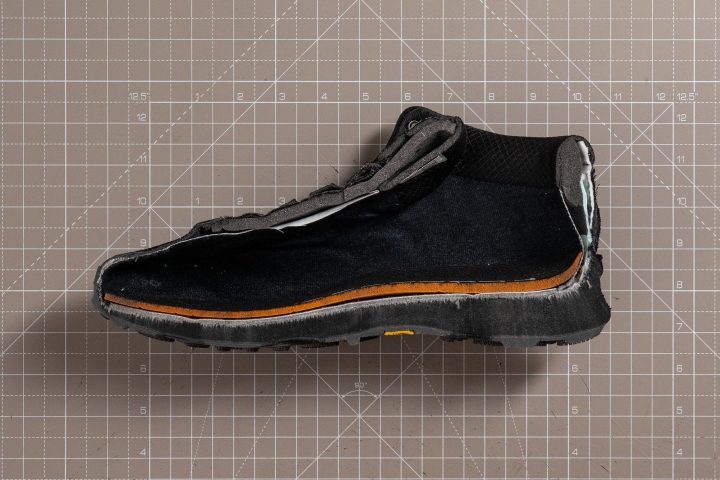
For those who prefer a more parallel-to-the-ground hiking experience, we recommend looking into the zero-drop Altra Lone Peak Hiker 2 instead.
| For those who prefer more ankle mobility while hiking, the low-top | 14.7 mm |
| Average | 13.6 mm |
Midsole softness
Pressing our durometer against the midsole yields a positively plush reading of 18.6 HA.
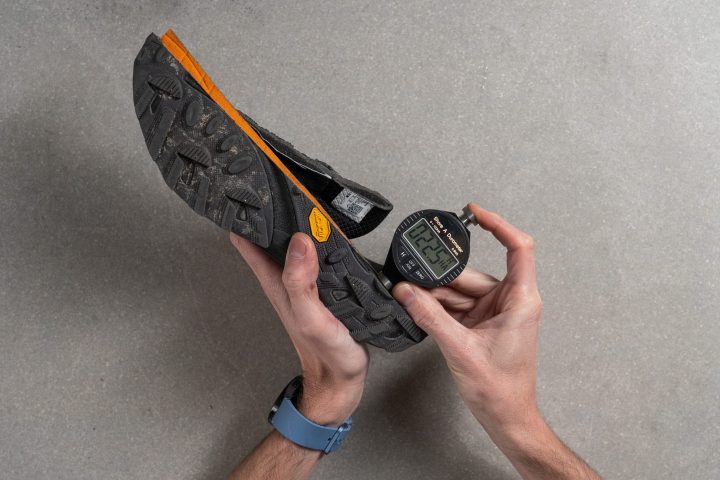
This means that we enjoyed incredibly soft and luxurious landings no matter how rugged and harsh the terrains we traversed were.
What's more, the midsole has a delicious rebound that puts a little spring in our step which, in conjunction with its feathery frame, makes the For those who prefer more ankle mobility while hiking, the low-top ride more like a trail runner than a boot. As a result, we frequently found ourselves tearing through the mile markers of our favorite trails swiftly and comfortably.
| For those who prefer more ankle mobility while hiking, the low-top | 18.6 HA |
| Average | 27.0 HA |
Difference in midsole softness in cold
We left the For those who prefer more ankle mobility while hiking, the low-top in the freezer for twenty minutes to simulate exposure to cold conditions. Taking another durometer reading of the midsole after that, we were so taken aback that we had to check that the freezer was running properly.
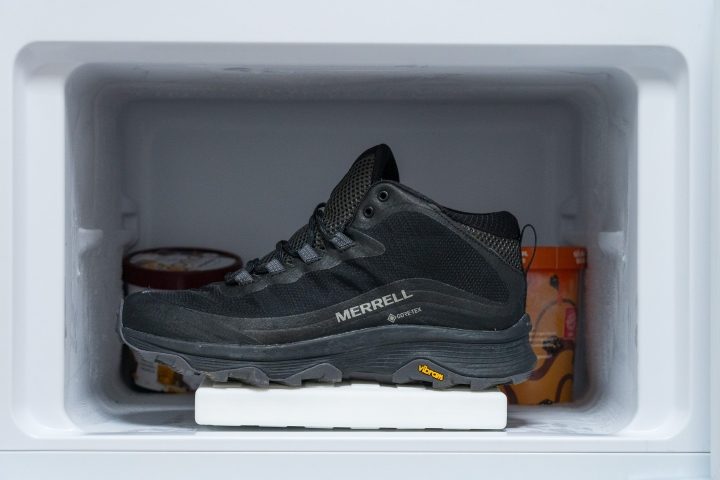
The For those who prefer more ankle mobility while hiking, the low-top only becomes 4% firmer when exposed to cold conditions, giving us a still plush reading of 19.4 HA. This isn't only softer than the average boot under similar conditions, but at room temperature too. This incredibly consistent performance means that the For those who prefer more ankle mobility while hiking, the low-top should feel just as comfy and well-cushioned during frigid winter treks.
| For those who prefer more ankle mobility while hiking, the low-top | 4% |
| Average | 19.7% |
Insole thickness
The For those who prefer more ankle mobility while hiking, the low-top's insole falls within the average range for hiking boots at 5.8 mm thick according to our caliper measurements. This provides us with a well-padded surface within the shoe that complements the midsole cushioning nicely.
| For those who prefer more ankle mobility while hiking, the low-top | 5.8 mm |
| Average | 6.1 mm |
Stability
Lateral stability test
For a shoe with such a high stack of plush foam, we were surprised at just how well-planted we felt when shifting our weight from side to side in the shoe.
That being said, we don't recommend schlepping a heavy pack over long distances in this shoe as sinking into that soft cushioning will require constant corrections for balance which will likely lead to foot fatigue and loss of stability over time.
Torsional rigidity
The For those who prefer more ankle mobility while hiking, the low-top was quite difficult to bend and twist in our hands during our manual assessment, earning it a rather stiff 4 out of 5 on our subjective scale. This means that the shoe resists and mitigates any excessive lateral movements of our foot and maintains a relatively firm and stable base that helps to ensure steady landings.
| For those who prefer more ankle mobility while hiking, the low-top | 4 |
| Average | 4.3 |
Heel counter stiffness
We found the heel counter to also feel quite rigid as we probed and squeezed at it, earning the For those who prefer more ankle mobility while hiking, the low-top another 4 out of 5 on our subjective scale. This explains the incredible ankle support we enjoyed while testing the boot, with no hint or sign of rolling even when traversing uneven terrains.
| For those who prefer more ankle mobility while hiking, the low-top | 4 |
| Average | 3.4 |
Number of shoes
The For those who prefer more ankle mobility while hiking, the low-top's midsole is about as wide as our current lab average at 112 mm wide according to our caliper measurements. This gives us more than enough of a platform to ensure stable landings and smooth transitions as we move around in the shoe.
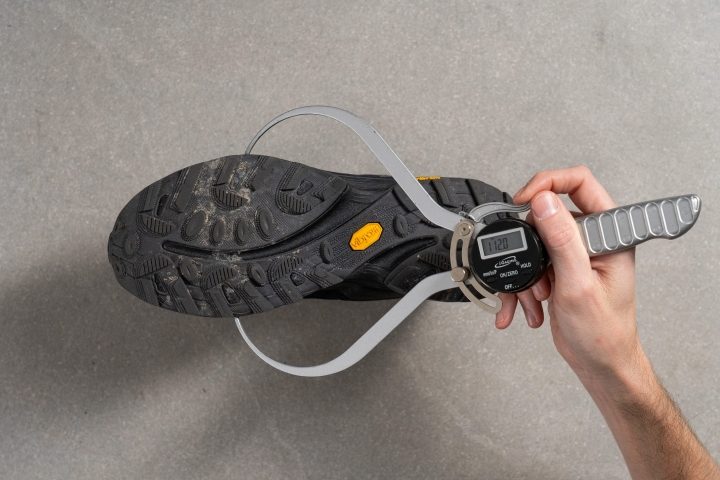
| For those who prefer more ankle mobility while hiking, the low-top | 112.0 mm |
| Average | 111.7 mm |
Our top pick in
This average motif extends back at the heel where the For those who prefer more ankle mobility while hiking, the low-top's midsole measures 89.3 mm wide.
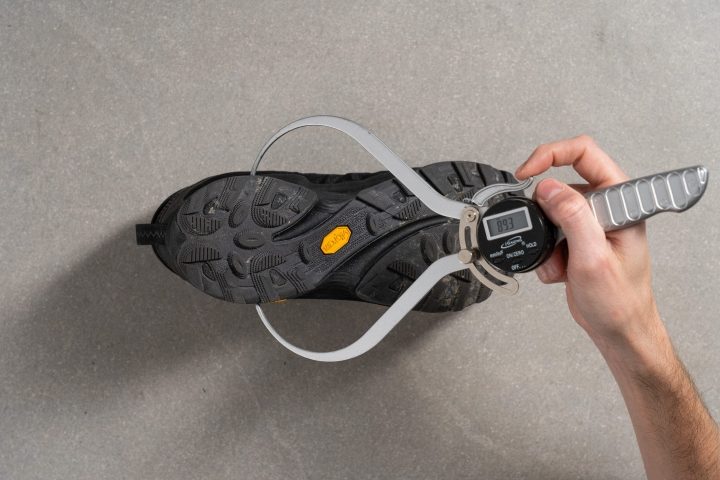
| For those who prefer more ankle mobility while hiking, the low-top | 89.3 mm |
| Average | 87.9 mm |
Flexibility
Stiffness
Once secured to our workbench, we found that 39.1N of force is needed to bend the boot to 90 degrees. This makes the For those who prefer more ankle mobility while hiking, the low-top is about as flexible as the average hiking boot.
As such, the boot is able to conform to the natural flexion of our foot to a certain extent while still having enough resistance to feel supportive and responsive underfoot.
| For those who prefer more ankle mobility while hiking, the low-top | 39.1N |
| Average | 43.8N |
Stiffness in cold
Retesting the flexibility of the For those who prefer more ankle mobility while hiking, the low-top after chilling in our freezer for twenty minutes reveals that it remains about as consistent as the average hiking boot under similar conditions; becoming only 28.8% more stiff.
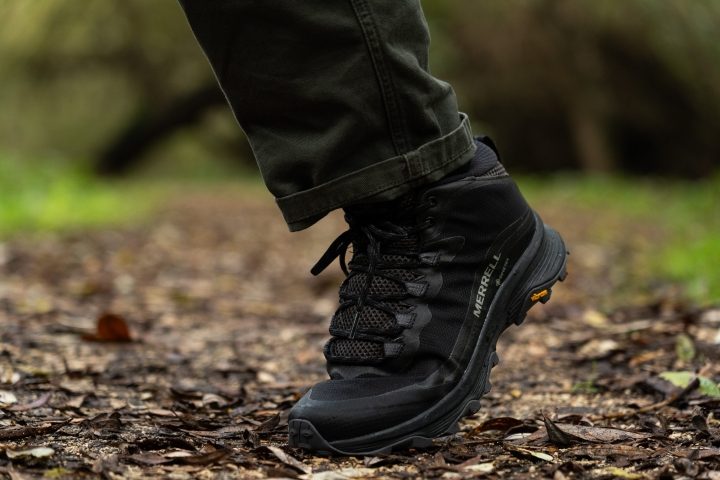
With 50.4N now required to bend the For those who prefer more ankle mobility while hiking, the low-top to the desired point, it's undoubtedly stiff but shouldn't feel like a tale of two boots between summer and winter.
| For those who prefer more ankle mobility while hiking, the low-top | 28.8% |
| Average | 26% |
Grip / Traction
Lug depth
The For those who prefer more ankle mobility while hiking, the low-top's lugs are just shy of our current lab average at 3.5 mm thick.

Apart from the thickness of the lugs, their varied shapes along the outsole form a multidirectional tread pattern that provides us with excellent traction over a variety of surfaces. Even slick or muddy trails were no obstacle for these grippy boots.
| For those who prefer more ankle mobility while hiking, the low-top | 3.5 mm |
| Average | 4.2 mm |
Size and fit
Toebox width at the widest part
We measured the For those who prefer more ankle mobility while hiking, the low-top's toebox at its widest point to be 100.9 mm wide according to our caliper. This is withing the average range for hiking boots and means that the For those who prefer more ankle mobility while hiking, the low-top should be accommodating enough even for those with broad feet.
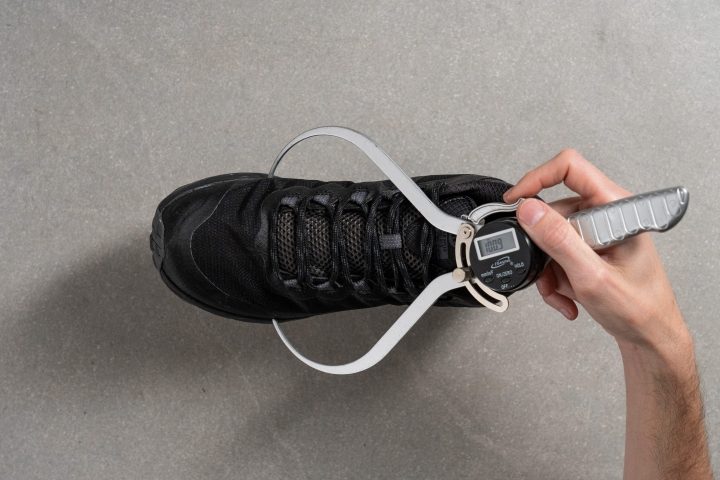
| For those who prefer more ankle mobility while hiking, the low-top | 100.9 mm |
| Average | 101.7 mm |
Toebox width at the big toe
Moving up to the area around the big toe, the For those who prefer more ankle mobility while hiking, the low-top's toebox is also on par with our current lab average at 80.5 mm based on our caliper measurements. This gives us ample room to splay out naturally without butting up against the sidewalls, even when making descents.
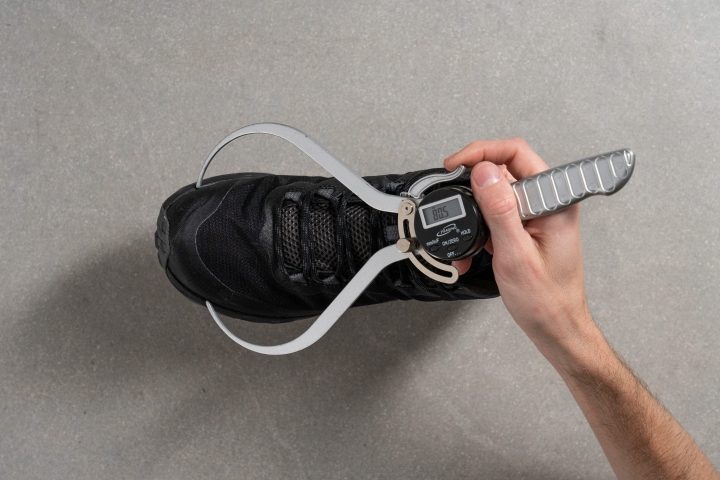
| For those who prefer more ankle mobility while hiking, the low-top | 80.5 mm |
| Average | 78.3 mm |
Tongue: gusset type
As is the case with most waterproof hiking boots, the For those who prefer more ankle mobility while hiking, the low-top is fully gusseted on both sides. This not only prevents bits of debris from entering the boot but also prevents water from seeping in and soaking our socks.

| For those who prefer more ankle mobility while hiking, the low-top | Both sides (full) |
Comfort
Tongue padding
Using our caliper, we measured the For those who prefer more ankle mobility while hiking, the low-top's tongue to be 13.2 mm thick. This is slightly thicker than our current lab average and means that we enjoyed excellent comfort around the instep with no hint of lace bite during our test hikes.
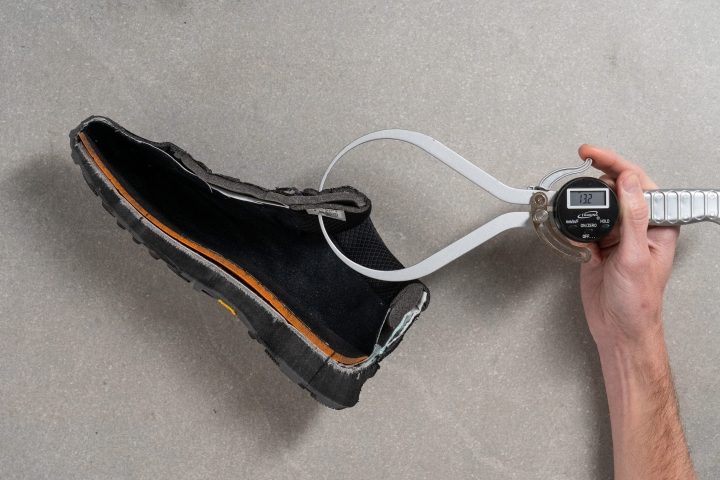
| For those who prefer more ankle mobility while hiking, the low-top | 13.2 mm |
| Average | 11.1 mm |
Heel tab
The For those who prefer more ankle mobility while hiking, the low-top sports a handy little finger loop at the heel which makes sliding the boot on a little easier.
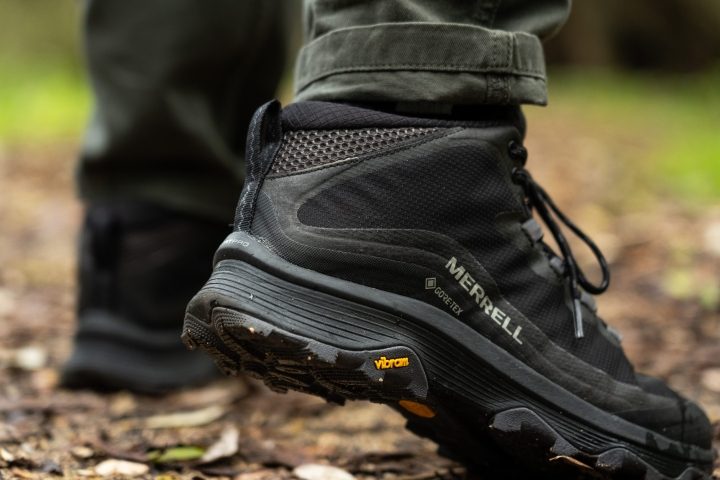
| For those who prefer more ankle mobility while hiking, the low-top | Finger loop |
Removable insole
The For those who prefer more ankle mobility while hiking, the low-top's insole is fully removable so replacing it with a custom orthotic is possible in the event that added arch support is required.
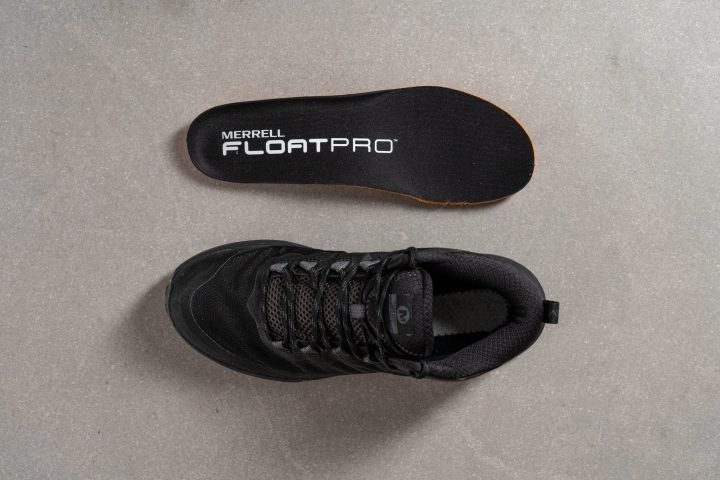
| For those who prefer more ankle mobility while hiking, the low-top | Yes |
Misc
Reflective elements
The For those who prefer more ankle mobility while hiking, the low-top features reflective elements running along the laces that provide decent nighttime visibility.
| For those who prefer more ankle mobility while hiking, the low-top | Yes |









































